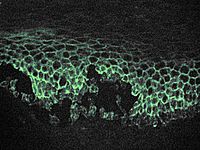| Pemphigus | |
|---|---|
 | |
| Pemphigus on the upper body | |
| Specialty | Dermatology |


Pemphigus (/ˈpɛmfɪɡəs/ or /pɛmˈfaɪɡəs/) is a rare group of blistering autoimmune diseases that affect the skin and mucous membranes.[1] The name is derived from the Greek root pemphix, meaning "blister".[2]
In pemphigus, autoantibodies form against desmoglein, which forms the "glue" that attaches adjacent epidermal cells via attachment points called desmosomes. When autoantibodies attack desmogleins, the cells become separated from each other and the epidermis becomes detached, a phenomenon called acantholysis. This causes blisters that slough off and turn into sores. In some cases, these blisters can cover a large area of the skin.[3]
Originally, the cause of this disease was unknown, and "pemphigus" was used to refer to any blistering disease of the skin and mucosa. In 1964, researchers found that the blood of patients with pemphigus contained antibodies to the layers of skin that separate to form the blisters.[4][5] In 1971, an article investigating the autoimmune nature of this disease was published.[6][7]
- ^ Yeh SW, Ahmed B, Sami N, Ahmed AR (2003). "Blistering disorders: diagnosis and treatment". Dermatologic Therapy. 16 (3): 214–23. doi:10.1046/j.1529-8019.2003.01631.x. PMID 14510878.
- ^ "Definition of PEMPHIGUS". www.merriam-webster.com. Retrieved 2017-03-11.
- ^ International Pemphigus & Pemphigoid Foundation: What is Pemphigus?
- ^ Beutner, EH; Jordon, RE (November 1964). "Demonstration of skin antibodies in sera of pemphigus vulgaris patients by indirect immunofluorescent staining". Proceedings of the Society for Experimental Biology and Medicine. 117 (2): 505–510. doi:10.3181/00379727-117-29622. PMID 14233481. S2CID 9443044.
- ^ "Dermatology Foundation: BEUTNER, JORDAN SHARE 2000 DERMATOLOGY FOUNDATION DISCOVERY AWARD". Archived from the original on 2008-05-18. Retrieved 2009-01-31.
- ^ Jordon, Robert E.; Sams Jr., W. Mitchell; Diaz, Gustavo; Beutner, Ernst H. (1971). "Negative Complement Immunofluorescence in Pemphigus". Journal of Investigative Dermatology. 57 (6): 407–410. doi:10.1111/1523-1747.ep12293273. PMID 4108416.
- ^ Serratos, BD; Rashid, RM (Jul 15, 2009). "Nail disease in pemphigus vulgaris". Dermatology Online Journal. 15 (7): 2. doi:10.5070/D34X05D6VH. PMID 19903430.